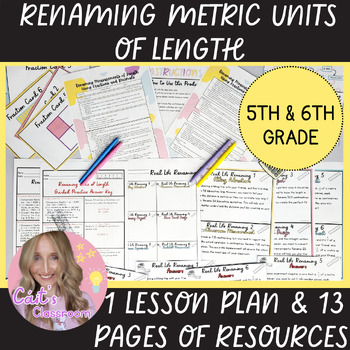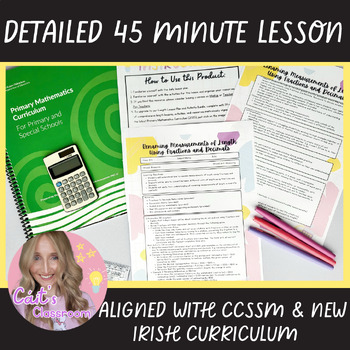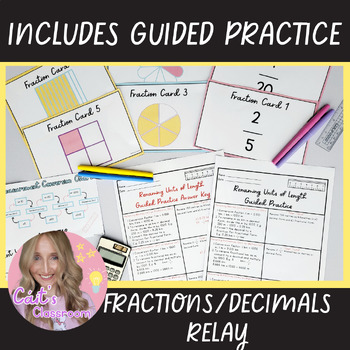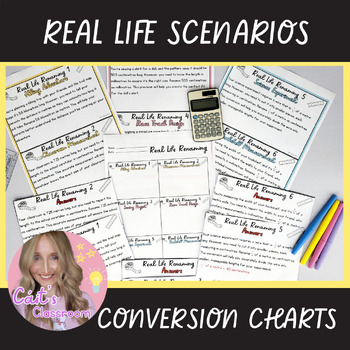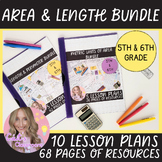Renaming Length Math Lesson Plan│Worksheets, Game, Guided Practice│5th/6th Grade
- PDF
Also included in
- 5 lesson plans & 42 pages of activities/resources on metric units of length measurement and perimeter for fifth and sixth grade. Revolutionize your math classes with this comprehensive resource covering topics such as:Selecting, Estimating, Comparing and Measuring Metric Units of LengthMetric SyPrice $16.84Original Price $23.35Save $6.51
- 10 lesson plans & 68 pages of activities/resources on area, perimeter and length for fifth and sixth class.Revolutionize your math classes with this comprehensive resource covering topics such as:Measuring, calculating, and converting square metres to square centimetres.Calculating, converting,Price $26.40Original Price $40.53Save $14.13
Description
Looking for an engaging lesson for fifth/sixth grade on renaming lengths in metric units? Want it to include worksheets, a game and guided practice? Then this resource is for YOU!
Take the stress out of creating complete lesson plans and resources! This lesson reinforces student understanding of metric system conversions through hands-on activities involving fractions and decimals.
This resource is also aligned with both CCSSM and the Irish Primary Mathematics Curriculum (2023) for seamless integration into planning documents.
Say goodbye to weekends planning on your laptop and hello to an engaged classroom – grab your copy TODAY!
Benefits
- Reduces planning demands on teachers, saving valuable time and effort while being well-designed and aligned with curriculum standards.
- Offers a complete, print-and-go resource with step-by-step instructions, ideal for newly qualified teachers who want support teaching maths to the senior classes.
- Enhances student understanding of renaming metric units of length using fractions and decimals for accurate communication and problem-solving.
In Depth Description
This 45-minute lesson plan includes:
- 6 fractions to decimals relay race cards.
- 2 conversion charts in both black and white and color.
- 1 guided practice worksheet with an answer key.
- 6 real-life scenarios with an accompanying worksheet and answer key.
- 3 learning objectives.
- Differentiation strategies for both struggling and advanced students.
- Formative and summative assessment ideas.
- Key vocabulary and definitions.
- Explicit links to the new Irish Primary Mathematics Curriculum (2023), focusing on the element of communication and the competencies of being an active citizen and an effective communicator.
- Explicit links with CCSSM
Mathematical Practice Standards:
- Make sense of problems and persevere in solving them (MP.1): Students should be able to make sense of the problems, understand the problem situation, and persevere in finding a solution.
- Model with mathematics (MP.4): Students should apply the mathematics they know to solve real-world problems.
5th Grade:
- CCSS.Math.Content.5.MD.A.1: Convert among different-sized standard measurement units within a given measurement system (e.g., convert 5 cm to 0.05 m), and use these conversions in solving multi-step, real-world problems.
6th Grade:
- CCSS.Math.Content.6.RP.A.3.d: Use ratio reasoning to convert measurement units; manipulate and transform units appropriately when multiplying or dividing quantities.
Don't let this opportunity slip away! Elevate your teaching experience and engage your students - secure your complete lesson plan and resources TODAY!
Click here to join the Cáit's Classroom mailing list for valuable tips, tricks, and special offers designed to support newly qualified teachers in effectively teaching maths to 3rd-6th class students.
Related Products
⭐ Length Operations Math Lesson Plan│Worksheets & Game│Metric System│5th/6th Grade
⭐ Perimeter Math Lesson Plan│Scale Drawing Perimeter Worksheet│5th/6th Grade
⭐ 2D Perimeter Math Lesson Plan│Worksheet & Hands-on Activities│5th/6th Grade
⭐ Length Measurement Lesson Plan│Worksheets, Activities, Visual Aids│5th/6th Grade

